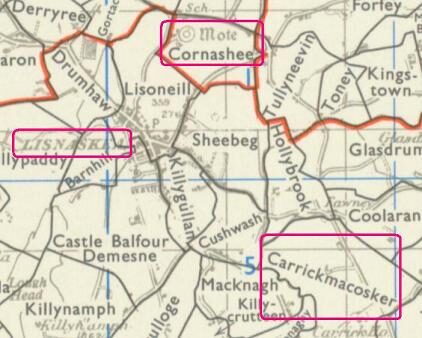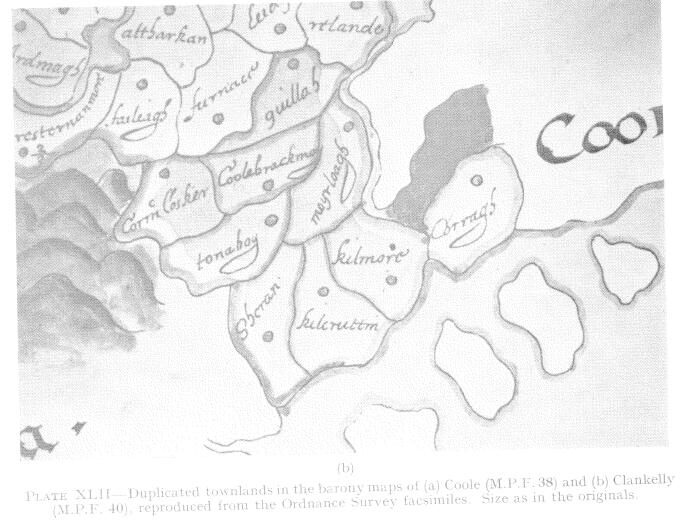Carrickmacosker
The first Maguire king, Donn Carragh Maguire, 1260 – 1302, was born at Lisnaskea, Co Fermanagh, and Lisnaskea served as the center of power for the senior Maguire line until 1625.
Donn Carragh, and subsequent kings, were crowned at Sciath Gabhra. All the authorities take it that Sciath Gabhra was the Mote Fort, in the townland of Cornashee, about a mile from Lisnaskea. It is very likely the site of a pre-Christian burial mound and because of its hallowed past was probably chosen as the coronation place of the Maguires. It was said by a local Maguire historian that when the Maguire chiefs and princes were inaugurated that signal fires were set ablaze on the mound. These fires signaled to the surrounding communities and clans that a new Chieftain had been chosen.
Cornashee translates to ‘hill of the fairy mound’

Carrickmacosker is about 3 miles from Lisnaskea, the birthplace of Donn Carrach, and about 5 miles from our ancestral inauguration site, and its close proximity to these places of Maguire power must indicate its importance. We believe that Carrickmacosker (and our family names) originated with the sons of Oscar Maguire (mac Oscair). Oscar was the great-grandson of King Donn Carragh.
The Townland of Carrickmacosker is located in Co Fermanagh in Northern Ireland.
Here is additional information on the possible beginning of Carrickmacosker, and of the McCosker / McCusker / McOsker families.
Excerpt from a conversation between Researchers Dr Kay Muhr and Dr Patrick McKay,
“I've come across a reference from the Omnasticum that may solve the riddle about whose 'quarter'
Carrow Mhic Oscair was. Under Achadh Urchaire (Aghalurcher) is the following: "Muiris mac Matha mic Osgair Meg Uidhir, i. airchideochain Clochair persun Achaid Urchuire tigherna Claín-indsi Rossa Oirrthir", So a Mac Oscair also a churchman - archdeacon of Clogher, parson of Aghalurcher, "lord" of Cleenish and Rossorry.”
Dr Kay Muhr and Dr Patrick McKay,
Northern Ireland Place-Name Project
c/o Irish & Celtic Studies, School of Languages, Literatures & Arts
Queen's University Belfast, BT7 1NN.
Ken McOsker’s notes:
“Muiris mac Matha mic Osgair Meg Uidhir, airchideochain Clochair persun Achaid Urchuire tigherna Claín-indsi Rossa Oirrthir” translates to “Maurice, son of Matthew, son of Oscar Mag Uidhir, archdeacon of Clogher, parson of Aghalurcher and lord of Cleenish and Rossorry". According to the Annals of Ulster, Maurice the son of Matthew MacOscair, died in the year 1423.
The Annals of Ulster, compiled in the 15th century, recorded only the most noteworthy people and events in Irish history. Not only is Maurice mentioned, but so is his wife Joan.
“Joan, daughter of the bishop Mac Cathmhail, wife of Maurice Mag Uidhir, that is, of the great Archdeacon, died on the 13th of the Kalends of February (Jan. 20 1427); one, that maintained a guest-house at Claeninis and at Ros-oirther for six and fifty years reputably, humanely and charitably.”
An Archdeacon to a Bishop was a Deacon, but of an administrative high rank, and often would have been promoted to the rank of Bishop, and therefore Priests would have looked upon him as a leader. As Maurice was titled “The great Archdeacon”, one would assume that our early family was of great importance to the church, and it is quite believable they could have been the namesake of the townland Carrickmacosker.
Maurice may have had greater influence than we first realized. Below is an excerpt from a paper titled “Cathal Mac Maghnusa and the Annals of Ulster” presented to the Clogher Historical Society, by Aubrey Gwynn in 1958. Gwynn (1892 – 1983) was an Irish Jesuit historian, and the subject of his paper, Cathal Mac Maghnusa (1439 – 1498), was a principle complier of The Annals of Ulster. Gwynn writes:
“Here in the diocese of Clogher things were no better, and no worse than in most other Irish dioceses. At the beginning of the fifteenth century, when the Papacy was itself fatally divided into two rival camps by the Great Schism, which began in 1378 and was not ended until 1418, Muiris Mag Uidhir son of Matthew son of Oscar was archdeacon of Clogher, parson of Aghalurcher and lord of Cleenish (Clain-inis) and Rossory (Ros-oirrther). He died on 26 April, 1423, and Ruaidhri Ua Luinin has added in the margin beside this obit the brief commentary : ' the great archdeacon.' Those three short words tell the whole of a long story. To put it very briefly and plainly, no one who was not himself a direct descendant or a close kinsman of the great archdeacon had any real hope of obtaining a good living in the diocese of Clogher for the next two generations.”
The following two maps are obtained at https://maps.osni.gov.uk.
They show the present day townland of Carrickmacosker.
The Townland of Carrickmacosker has had several names over the centuries,
but always based around McOsker.
The earliest reference we have found is CormcCosker in the year 1609. Cor translates to "a round hill"
The following is from "The Maps of the Escheated Counties of Ulster, 1609-10" by J. H. Andrews
published in Proceedings of the Royal Irish Academy. It shows CormcCosker in the barony of Clankelly.

You can see the proximity of Carrickmacosker and Drumskinny (the birthplace of Hugh McOsker)
on the following picture. Enniskillen, the location of Maguire's Castle is directly between the two.
The yellow line shows the border between Northern Ireland and the Republic of Ireland.
The light green line north and east of Drumskinny and Carrickmacosker
completes the border of Co. Fermanagh.
Maguire's Castle in Enniskillen was the seat of power for the Maguire Clan in Co. Fermanagh.
The earliest reference to Enniskillen Castle occurs in 1439 in the Annals of Ulster and refers to King Tomas Og Maguire being held prisoner at his own castle in Enniskillen by Domnall Maguire ‘the Freckled’, and liberated eventually by Henry O’Neill.
However, Hugh Maguire, the reputed builder, died in 1428, so, if this tradition is correct, the castle was obviously built before then. Hugh’s death took place in Kinsale in county Cork as he returned with his nephew from a pilgrimage to the shrine of Saint James at Compostella in Spain.
The Maguire stronghold at Lisnaskea remained the seat of the ruling chieftains until 1484, when Sean Maguire became the first member of the Enniskillen branch of the family to be elected chieftain.
From this time and throughout the following century all but two of the Maguire chieftains came from Enniskillen Castle, thus establishing it as a power centre in Fermanagh.
Remember that we speculate the McOsker (MacOscair) branch split from the Maguires around the year 1375. Possibly 100 years before this ancient castle was built.
Click here for information on the castle.
